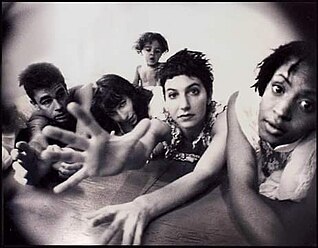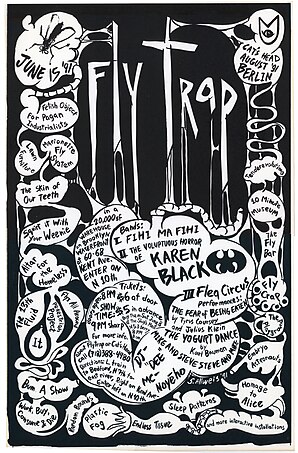 Global Information
Global InformationBrooklyn Immersionists information
Innovating an ecological culture eventually referred to as Immersionism, the Brooklyn Immersionists were a community of artists, musicians and writers that integrated themselves and their creations into an industrial area of Williamsburg, Brooklyn in the 1990s.[1] According to the art historian, Jonathan Fineberg, Williamsburg's creative community was devoted to "a richer, more dynamically interacting whole,"[2] and explored new forms of interconnected art and culture in the streets, rooftops, abandoned warehouses and local media networks. Separated from Manhattan's arts institutions and aesthetics, the Immersionists moved beyond a postmodern preoccupation with surfaces and issues of interpretation, and shifted into a non-objective ethic of nurturing the world around them.[2] The catalytic, communal and philosophical culture was discovered by the international press and attracted thousands of artists to a district that had been losing jobs overseas and coping with a burgeoning drug trade.[3]

Despite disruptions by city-sponsored developers and Manhattan's commercial press in the new millennium, the Immersionists and their activist colleagues catalyzed a renaissance in Williamsburg that spread through much of Brooklyn, establishing that borough as an international hub for creative talent, activism and urban ecology.[4] [5] Growing up during the civil rights and environmental movements of the 1960s and 1970s, and moved by the conditions of their decaying waterfront in Brooklyn, the community began a search for a more ecological sense of being, art and culture.[6] Their innovations in "submodern,"[1] "omnisensorial,"[6] and networked culture[7] anticipated developments in the arts, media, philosophy, journalism and psychology that came to fruition in the 21st century.[8]

Although some journalists have attempted to reduce Brooklyn's rich and extensive creativity to pejorative lifestyle labels like “hipsters” and “bohemians,” a far more engaged culture of nurturing and community building was actually in play. In 1991, early in the evolution of the Immersionist scene, Mark Rose used the term “aesthetic activism”[9] in The New York Press, and in 1998, Suzanne Wines wrote in Domus of "New York's most vibrant art scene... constantly responding to new input.”[6] The Domus article was one of the first instances where the international press used the term "immersive"[6] to describe the creative community by Williamsburg's waterfront. Underscoring the ecological depth of the immersionist movement in his book, The Williamsburg Avant-Garde: Experimental Music and Sound on the Brooklyn Waterfront, Cisco Bradley states that the community not only shifted the center of New York's creativity towards Brooklyn, but significantly helped to change the discourse of the arts in New York.
"In many ways, Immersionism was the next stage of evolution of the New York art scene, which had evolved from the rationalist works of figures like conceptual artist Joseph Kosuth (b. 1945) or minimalist Donald Judd (1928–94) to the postmodern rebellion of the 1980s... As some of the early theorists of Immersionism stated, ‘[Immersionists] helped to shift cultural protocols away from cold, postmodern cynicism, towards something a whole lot warmer: immersive, mutual world construction.'[10]"[1]
While creative districts in New York had begun to emerge in Manhattan's West Village in 1900, Harlem in the 1920s and 30s, the East Village in the 1950s, SoHo in the 1960s and 70s, and reemerged in the East Village in the 1980s, Williamsburg's Immersionist community gave rise to the largest renaissance in New York to take root outside Manhattan.[11][12] This was a significant shift celebrated as early as 1993 in the exhibition, Out of Town: The Williamsburg Paradigm, curated by Jonathan Fineberg for the Krannert Art Museum at the University of Illinois.[13]

Rather than direct their creative life towards specialized art establishments in Manhattan, especially those which had become locked into skeptical and ironic modes of expression, the Immersionists disengaged from the product focus of Manhattan's culture industry and began to cultivate a web of interpenetrating creativity in the streets, rooftops, warehouses and weed-strewn waterfront. The ecological nature of the Immersionist movement is noted by curator, Brainard Carey on the website for his arts program on Yale University Radio, WYBC (AM):
"The creative community that came together during the early 1990s in Williamsburg, now referred to as the Immersionists, shared a common interest in cultural innovation and deep involvement in their local environment."[14]
Much of Williamsburg’s industrial area near the waterfront was turned into a medium of expression, with increasingly large interdisciplinary events in the abandoned warehouses attracting attention from a wide variety of media. The multidisciplinary press included The Village Voice,[15] The New York Press,[16] The Drama Review,[17] Flash Art,[18] Wired,[19] The New York Times,[20] The New Yorker,[21] The Utne Reader,[22] Domus,[6] The Guggenheim Museum CyberAtlas,[23] Die Zeit,[11] Newsweek,[24] and Fuji Television.[25] At least four major art history books have reflected on the movement, including Jonathan Fineberg's Art since 1940: Strategies of Being,[26] and Cisco Bradley's The Williamsburg Avant-Garde.[1] The international “artists colony”,[11] as the German newspaper, Die Zeit referred to the interdisciplinary community near the waterfront, was composed of immigrants from across the Americas, Africa, Asia, Europe and the Middle East.[11] Seeking affordable spaces to live and work, the experimental artists found themselves in a distressed and toxic environment which they began to treat as a living medium worthy of caring and creative involvement.[3]

The Immersionists' environmental ethic was evident in its nomenclature. Groups and art collectives emerged that often invoked animals, ecosystems and healing in their names and manifestoes. One of the earliest of Williamsburg's creative organizations, El Puente (The Bridge) opened in 1982 and referenced its commitment to deep, restorative connection to local youth. A series of large, community-building efforts in the streets and abandoned warehouses also signaled a devotion to the living world, beginning in 1990 with a playful nod to animal sensuality, The Sex Salon. That was followed by the Cat's Head (I & II), Flytrap, Human Fest (I & II), El Sensorium and Organism. Strategies for these events used equally biomorphic terms like “web jam,”[24] “omnisensorial,”[24] and “circuitous systems."[27]

Storefront venues and mobile theater and media groups began to emerge in parallel with the large, creative confluxes, and shared in the community-building process: Minor Injury Gallery, The Bog, The Lizard's Tail, Nerve Circle, Keep Refrigerated, the Green Room, the Outpost, Hit and Run Theater, Fakeshop and Lalalandia. In the mid 1990s, interdisciplinary establishments appeared that followed in both the biomorphic naming tradition and the locally rooted, interactive culture: Mustard, The AlulA Dimension, Floating Point Unit, Galapagos, Ocularis and Ongolia. Local media emerged that helped to build a discourse around participation, biological feedback systems, and ecological sensitivity. These included Breukelen, The Curse, The Nose, The Outpost, Waterfront Week, Worm Magazine and (718) Subwire.[14] Migrations of artists and musicians between groups were extensive, leading to a rich, creative weave of ideas and resources.
The Immersionists' deep involvement with their neighborhood gradually grew into a wave of cultural change and small business growth that transformed the entire borough.[8] According to Lance Freeman and Frank Braconi in the Journal of the American Planning Association, the sense of hope that returned to the struggling industrial district helped to lower the attrition rates for the disadvantaged in the 1990s. Beginning in 1999, however, the City of New York began to leverage the Immersionist movement to promote corporate welfare infrastructure for developers. According to Freeman and Braconi, the City’s new policies caused the attrition rates for economically disadvantaged populations to rise again.[28] The Immersionists themselves were among the communities displaced.
- ^ a b c d Cite error: The named reference
:28was invoked but never defined (see the help page). - ^ a b Introduction by Jonathan Fineberg to the catalogue for the exhibition, Out of Town: The Williamsburg Paradigm, curated by Fineberg for the Krannert Art Museum (University of Illinois, 1992).
- ^ a b "Brooklyn Youth Gangs Concentrating on Robbery," The New York Times, Thursday, August 1, 1974.
- ^ Zornosa, Laura (July 22, 2021). "The Music Scene in This Brooklyn Neighborhood Is Here to Stay". The New York Times.
- ^ van der Heijden, Anna (May 9, 2019). "Sustainable Brooklyn Bridges the Gap Between the Environmental Movement and Communities of Color". Bushwick Daily.
- ^ a b c d e Cite error: The named reference
:43was invoked but never defined (see the help page). - ^ Editorial by Kit Blake, Word of Mouth, November, 1989, p. 2.
- ^ a b Cite error: The named reference
:0was invoked but never defined (see the help page). - ^ Cite error: The named reference
:46was invoked but never defined (see the help page). - ^ Susie Kahlich, Ethan Pettit, Ebon Fisher, "Immersionism, a Brief Introduction," Facebook, February 13, 2011, https://www.facebook.com/notes/ethan-pettit/immersionism/501003277687
- ^ a b c d Steinberg, Claudia, "Vis a Vis Manhattan," Die Zeit, September 19, 1997, p. 77
- ^ Zukin, Sharon (2010). Naked City: The Death and Life of Authentic Urban Spaces. Oxford University Press. pp. 42–45. ISBN 978-0-19-974189-2.
- ^ Out of Town: The Williamsburg Paradigm, catalog to exhibition by the same name at the Krannert Art Museum curated by Prof. Jonathan Fineberg (University of Illinois, 1992).
- ^ a b Carey, Brainard (July 20, 2016). "Interview with Ebon Fisher". Museum of Non-Visible Art.
- ^ Cite error: The named reference
:14was invoked but never defined (see the help page). - ^ Rose, Mark (March 6–12, 1991). "Brooklyn Unbound". The New York Press. p. 10.
- ^ Cite error: The named reference
:45was invoked but never defined (see the help page). - ^ Cite error: The named reference
bonamiwas invoked but never defined (see the help page). - ^ Cite error: The named reference
:15was invoked but never defined (see the help page). - ^ Cite error: The named reference
:47was invoked but never defined (see the help page). - ^ Cite error: The named reference
:22was invoked but never defined (see the help page). - ^ Fisher, Ebon (January–February 1995). "The Sex Salon & the Web Jam: Rediscovering the Value of Social Ritual". The Utne Reader.
- ^ Cite error: The named reference
:33was invoked but never defined (see the help page). - ^ a b c Cite error: The named reference
:10was invoked but never defined (see the help page). - ^ Cite error: The named reference
:12was invoked but never defined (see the help page). - ^ Fineberg, Jonathan (1995). Art Since 1940: Strategies of Being (2nd ed.). Englewood Cllffs, N.J.: Prentice Hall. pp. 467–471.
- ^ Cite error: The named reference
nissenwas invoked but never defined (see the help page). - ^ Cite error: The named reference
:6was invoked but never defined (see the help page).